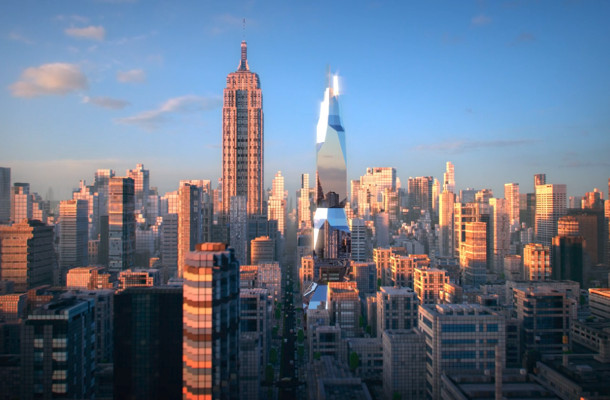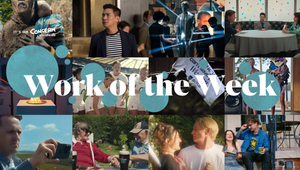
Architectural Post Production – The Ultimate Invisible Post?

“The cityscapes in films can help tell the story if used effectively. The design of the film environments can really contribute to the visual appearance of the film, whether setting a scene or locating the film.” Jonathan Gales, director at architectural focused film studio Factory Fifteen
When you think of visual effects the first things that pop into your mind are likely explosions, fire-breathing mythical creatures, world-ending natural disasters and so forth. But there’s an altogether different type of post production that affects almost every commercial and film made today, and that’s the stuff the viewer doesn’t notice. The ‘invisible post’.
One of the most common examples of this type of VFX - and one of the most common examples of post production, period - is the alteration or construction of architecture. This type of work makes up much of the world that a film’s protagonists live within, fitting seamlessly into the background unbeknownst to the viewers.
“Environment enhancement - often referred to as digital set extension - is a very common post assignment that is undetected to the viewing audience,” says Ben Walsh, a senior creative director at Method Studios. “Invisible post is often our goal in photoreal VFX work, so this part of our jobs can be unappreciated, especially if it’s adding to or changing a real location.”
And so what are the main factors that artists need to consider when creating architectural imagery?
Jonathan Gales, part of directing collective Factory Fifteen - which is made up of a trio of trained architects - surprisingly believes that the main challenges in this type of work revolves more around emotion than it does technicalities. “If the director chooses to add to or alter the environment in a film, they are making a decision that affects the look and feel of the film,” he says. “Technically, altering a cityscape is much less challenging than adding a VFX animal. I think the main challenges are in the thoughts behind why the cityscape is being altered, and the design process to decide why it looks the way it does. Cities are fascinating organisms with layers of history and culture, you can tell a lot from a city just from its skyline.”
He also notes that complexity of compositing with work like this due to the difficulties in integrating VFX behind people in live action footage. According to Jonathan, it’s especially hard if fast camera movement is involved or if the characters are crossing the frame, making a shot hard to track. “It’s also tough if they have long flowing or detailed hair. You essentially have to cut them out each frame – rotoscoping - which is time consuming, as you can imagine.”
That’s something Nic Seresin, creative director at The Underground NY, has also noted. “Difficulties involved with building are mainly getting the correct elements and accurate CAD (computer-aided design) data. A lot of cityscapes are made using matte paintings. If you're adding buildings into an existing live action plate it makes it a lot easier because of all the references you have to blend said building into. Difficulties also arise with complicated camera moves.”
For David Casey, head of commercials at The Embassy in Vancouver, a pivotal issue to consider, from a technical point of view, comes down to the integration of multiple facets. “You have to seamlessly integrate all the photographic nuances the filmmakers shot with. You also have to detail your elements in a realistic way. Too much detail makes it look over art directed, too little makes it looks too CGI. Creatively it’s all about striking a balance between the vision of the director, the reality of the locale and constraints of the filmed photography. That's a narrow tightrope to walk.”
Meanwhile his colleague Winston Helgason, president at The Embassy, stresses the importance of paying attention to buildings’ interiors. “If you are close enough to see into the buildings you are going to need to have builds for the rooms, furniture, lights, etc. Without them the viewer will notice the lack of parallax and depth.”
Once a structure has been designed and built, another important thing to consider is the way in which it communicates with its surroundings. Every buildings reflects light and shadow differently - just look at the Walkie Talkie building in London - and according to Ben at Method, thinking about this is almost as important as the design of the building itself. “I feel a lot of successful architects know how to use the geometry to create interest using both sunlight and permanent light sources,” he says. “In CGI, we try to take into consideration fundamentals of real world architecture and use that as inspiration.”
Randie Swanberg, who also works at Method Studios as a creative director, echoes the thoughts of his colleague. “There are many ingredients to a building’s structure that can become character attributes in a scene’s setting. Surface properties are the most important characteristic. For example, glass buildings are going to bounce light most effectively and the reflectivity gives an added sense of depth. Weathered stone or brick will absorb light and create an old feeling in the scene.”
Real world vs. fantasy
Onscreen architecture falls roughly into two categories. Firstly there are those rooted in the real world, based on present day or historical constructions that usually offer extensive imagery to refer to. Then there are the worlds that live in the realm of fantasy and science fiction, for example the locations in the new Blade Runner film.
“I think the best artists are built in equal measure with creative and technical skills. Each of the scenarios you mention test each of these skills,” believes David at The Embassy. “A real world cityscape is going to lean much more heavily on an artist’s technical skills. Getting the details accurate, matching the lens effects and lighting. On the other hand a fantastical environment will have an artist flex their creative muscles a bit more, especially when initial briefs for this work can often be quite broad. Neither is more difficult than the other, they are both unique complex challenges.”
His colleague Winston believes that projects conjured from the imagination do require more effort to look convincing, but also notes that when artists work on sci-fi cities they must employ techniques used when building ‘real’ architecture. “Real cities are based on the work of thousands of architects and engineers and builders. Sci-fi cities are usually designed by a few concept designers and the VFX artists have to interpret these designs and create something believable. To achieve this, you want to reference real world shading and lighting and employ these looks to your futuristic digital cities.”
Randie at Method sees different challenges in both techniques. Creating something historical requires a lot more research, determining the scale of objects and gathering as much visual data as possible before building from as accurate position as possible - but making modifications along the way if it’s aesthetically suitable for the project.
Building something fantastical, on the other hand, requires the designers and artists to establish a set of rules from which to build from. “What are the materials available?” Randie ponders. “How does transportation play a role in the layout? What level of technology is there in this world? Is gravity different? Once we have established those rules we can then begin design. However, just like the historical project, we may decide to break the rules whenever we see fit.”
Architectural CGI - the ultimate invisible post?
“I think that’s definitely true for certain projects,” says Winston from The Embassy when he considers whether CG city building is the ultimate form of ‘invisible post’. “Sometimes you are replacing a green screen backdrop with a city scape, as we did in Captain America 2: Winter Soldier, or localising a plate that is a shot from a different city and inserting recognisable landmarks from the city you are emulating. These type of shots are usually going for a seamless photo real execution.”
“Yes I would agree [that it’s the ultimate example of invisible post],” adds Nick from The Underground. “For cityscapes and buildings the CGI or matte painting anchors the shot in question. For example, the Smart Car commercial ‘U Turn’ (there’s a before and after video here) was shot in San Francisco but the city was made to look like Washington DC.”
David from The Embassy “agrees wholeheartedly” with Winston and Nic and believes that the challenge of crafting buildings in CGI is greater than that of creating magical creatures or characters.
“Viewers have a real world frame of reference for city locales or landscapes. Anything that has a sense of artifice the viewer is going to pick up on straight away. When dealing with fantastical creatures or outlandish effects viewers are much more willing to suspend their disbelief.”















